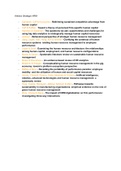Articles Strategic HRM
- Campbell, Coff & Kryscynski - Rethinking sustained competitive advantage from
human capital
- Coff & Raffiee - Toward a theory of perceived firm-specific human capital
- Hamilton & Sodeman - The questions we ask: opportunities and challenges for
using big data analytics to strategically manage human capital resources
- Jackson - Behavioral perspective of strategic human resource management
- Jiang, Lepak, Han, Hong, Kim & Winkler - Clarifying the construct of human
resource systems: relating human resource management to employee
performance
- Lepak & Snell - Examining the human resource architecture: the relationships
among human capital, employment, and human resource configurations
- Macke & Genari - Systematic literature review on sustainable human resource
management
- Marler & Boundreau - An evidence-based review of HR analytics
- Meijerink & Keegan - Conceptualizing human resource management in the gig
economy: toward a platform ecosystem perspective
- Raffiee & Byun - Revisiting the portability of performance paradox: employee
mobility and the utilization of human and social capital resources
- Vrontis, Christofi, Pereira, Tarba, Markides & Trichina - Artificial intelligence,
robotics, advanced technologies and human resource management: a
systematic review
- Yong, Yuslize, Ramayah, Jabbour Sehnem & Mani - Pathways towards
sustainability in manufacturing organizations: empirical evidence on the role of
green human resource management
- Zhou, Chang & Wang - The impact of HRM digitalization on firm performance:
investigating three-way interactions
,Campbell, Coff & Kryscynski - Rethinking sustained competitive advantage from
human capital
Human capital can be a source of sustained competitive advantage, but only if isolating
mechanisms prevent workers from taking their valuable knowledge and skills to rival firms
- Firm-specific capital: knowledge and skills embodied in individuals that cannot be
easily applied in other firms (firm’s proprietary technology or social landscape)
- Supports sustained competitive advantage
- General human capital does not
- Not owned, or fully controlled by the firm
Competitive advantage: if it is able to create more economic value than the marginal
(breakeven) competitor
Low use value of firm-specific skills affect the wages that alternative firms are willing to pay
for these skills in the labor market:
- FSHC have low exchange value
- Serves as a isolating mechanism:
- Workers with FSHC are less likely to leave voluntarily, and therefore, they are
less likely to take valuable general knowledge and capabilities to rival firms
- Even when these workers do leave voluntarily, the FSHC they take with them
cannot be perfectly deployed and utilized in rival firms
There are 3 important boundary conditions that constrain the applicability of FSHC when
seeking to explain sustained competitive advantage
1. Heterogeneous value of the portfolio of worker skills
a. Even though GHC are widely applicable in other firms, their use value may
differ considerably between firms because of different technologies, product
markets and complementary assets
b. If a rival firm has a more productive complementary asset, a workers general
skills may be more highly valued externally than they are by the current
employer
c. This may overshadow any FSHC not valued externally, thereby facilitating
mobility despite the presence of FSHC
d. Therefore, it is critical to analyze the nature of the entire portfolios of skills
rather than any single skill in isolation, because one skill may be of low
exchange value, but other might be of high value
e. Focusing on individuals skills in isolation provides an insufficient and perhaps
misleading understanding of how human capital influences mobility
BC1: a necessary condition for FSHC to function as an isolating mechanism is that
the exchange value of worker’s GHC is no greater than the use value of workers’ full
portfolio of HC in the focal firm (holding constant supply-side constraints on worker
mobility)
2. Imperfect information and exchange value
a. Real labour markets have information problems, making it very difficult for
hiring firms to evaluate the HC any individual possesses
b. It is likely that firms will incorrectly value the skills portfolio
, c. Can reduce this through personal recommendations or previous employment
relationships, or by offering low upfront compensation with the promise of
greater rewards if the worker is revealed of high quality
d.
e. Undervaluing a portfolio of highly transferable skills, consequence is that
workers are relatively immobile, even though their skills are highly
transferable
i. Undervalue because there is incomplete information about the
quality/quantity of worker’s knowledge and skills
ii. Firms may be able to observe worker’s skills but may be unwilling to
pay the full use value of those skills because of some other stigma
attached to the workers
f. Overvaluing a portfolio of highly firm-specific skills, consequence is that
workers are highly mobile, even though their skills are imperfectly transferable
i. Valuable GHC may be necessary before workers can successfully
acquire FSHC
ii. Valuable GHC may be codeveloped as workers make highly FS
investments
BC2: A necessary condition for FSHC to function as a isolating mechanism is that the
exchange value of worker skills and the firm specificity of those skills must be tightly coupled
(holding constant supply-side constraints on worker mobility)
3. Supply-side mobility constraints
a. A variety of labor market imperfections in real labor markets may constrain
employee mobility, independent of the specificity of their human capital





